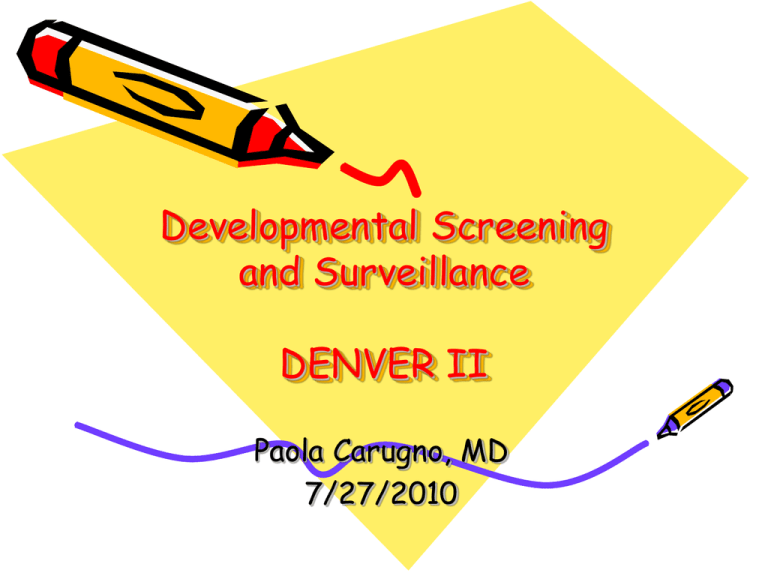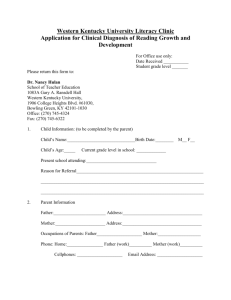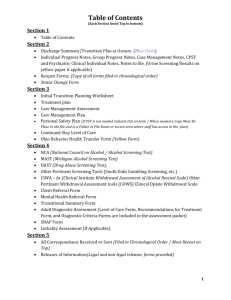Denver Developmental Screening Test 7/27/10
advertisement

Developmental Screening and Surveillance DENVER II Paola Carugno, MD 7/27/2010 Why me? • MDs have access to young children and families. • Familiarity with social, familial factors. • Professional guidelines: AAP Committee on Children with Disabilities, Bright Futures. Development in WCC • Surveillance • Screening • DDST II Surveillance • “… a flexible, continuous process in which a knowledgeable professional performs skilled observations of children during child health care” • USE IT AS A GROWTH CHART Screening Process of testing whole populations of children at various set ages to detect those at high risk for significant, unexpected deviations from normal. Screening • Process of identifying children with an atypical development. • About 16% of children have disabilities. • Early identification will improve outcome. How to screen? Variety of techniques currently in use: • Reviewing developmental milestones. Informal collection of age-appropriate tasks. • “Clinical judgment” based on history, exam. • Formal screening with standardized testing. Screening • • • • ASQ PEDS PEDS:DM DDST Surveillance • Components: – Eliciting/attending to parents’ concerns – Obtaining a relevant developmental history – Skillfully observing children’s development (not estimating) When to screen? • At least 3 times before age 3: – 9 month – 18 month – 24-30 month • Screening tests should be done when suspicions of delay arise DDST-R • Revised, re-standardized in 1988 • Sensitive, but with limited specificity and predictive value (high referral rate) • Use it to aid monitoring • Use in second stage screening (following a parents’ questionnaire) • Interpret the results in context of child’s functioning and circumstance. Denver II • • • • • 0 to 6 years Not an IQ test, not predictor of outcome Cannot generate a diagnosis Not a substitute for testing Just compares children of the same age Denver II • 4 Areas of function: – – – – Personal-Social, Fine Motor-Adaptive, Language, Gross motor. Calculating age • Date of test • Date of birth If needed, borrow: year month day year month day 12 30 • Adjusting for prematurity (if born more than 2 weeks early, and younger than 24 months) Age of the child, - weeks early (in months and days) Introduction • Reassure caregiver – Test is not an IQ test – The child is not expected to pass all items – Determine developmental status Administration • Flexible • Score what you see • Follow a certain order: First do items (R), less active participation, easier tasks, same materials on the table. Administration • 3 items to the left and – Every item crossed, OR – Every item until 3 failures are recorded (Ceiling). – If the child fails, then continue testing items to the left until 3 items are passed (Basal). Administration • Up to 3 trials • Test behavior • Item scoring: P (Passing), F (Fail), N.O. (no opportunity), R (refusal) Interpretation • Advanced items: Child passes an item to the right of the age line • Normal items: Child can pass, fail or refuse an item between the 25th and 75th% • Caution: refuses or fails an item between 75th and 90th % • Delayed: refuses or fails an item completely to the left of the age line. Follow up • Normal: no delays and a maximum of 1 caution. Routine follow up. • Questionable: 1 delay and/or 2 or more cautions. Offer stimulation suggestions and repeat in 3 months • Abnormal: 2 or more delays, or fails twice 3 months apart. Refer to EI.











